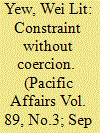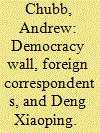|
|
|
Sort Order |
|
|
|
Items / Page
|
|
|
|
|
|
|
| Srl | Item |
| 1 |
ID:
149178


|
|
|
|
|
| Summary/Abstract |
How can we begin to understand “repression” when a soft authoritarian regime like Malaysia both tolerates yet simultaneously hinders environmental contention? I argue that addressing indirect repression in the form of state-imposed constraints is one such point of departure. Beneath the veneer of tolerance, repression still exists in subtler forms. Such unobserved constraints emerge mainly through non-coercive bureaucratic processes and procedures undertaken by state agents. Though aggregated effect may not defeat a movement, it nevertheless elevates the overall cost of collective action by circumscribing movement forms and options, and demobilizing resources and supporters. This perspective goes beyond the conventional issue_image_89_3_Environmental Protest Malaysia - EA photo1attention on coercion—the show and use of force—in non-democracies. Based primarily on activist accounts related to the Broga anti-incinerator campaign and the Kuantan protests against a rare earth plant in Malaysia, this article demonstrates how indirect repression, in the form of state-imposed constraints, is perceived, experienced, and responded to by activists. I point to four prominent ways in which the constraints indirectly undermine activists’ campaigns: ostentatious surveillance, judicial channelling, occupational repression, and administrative constraints. Intended or otherwise, constraints seem less costly than coercion and help absolve political rulers of direct culpability. Besides completing the picture of repressive patterns under authoritarianism in Malaysia, this article’s focus on constraints suggests that the authoritarian state is ambivalent about grassroots activism that does not challenge the political order.
|
|
|
|
|
|
|
|
|
|
|
|
|
|
|
|
| 2 |
ID:
149179


|
|
|
|
|
| Summary/Abstract |
This article identifies and explains the role of the Western media in Chinese politics between November 1978 and April 1979, when the rise of Deng Xiaoping within the Communist Party coincided with the emergence of the Democracy Wall free speech movement on China’s streets, and the normalization of Sino-American relations. At this critical juncture in twentieth-century history, foreign journalists in Beijing were much more than simply gatekeepers of a conduit to the outside world. Chinese activists believed that, through the Western media, they could reach domestic audiences in China, and potentially even the Party leadership. Indeed, foreign reporting contributed to the movement’s spread to issue_image_89_3_Foreign Correspondents China - EA Photo2other parts of the country, while strengthening and accentuating its most radical aspects. However, the main beneficiary of these interactions was Deng, who enlisted Democracy Wall and the foreign media, at times in conjunction, to advance his domestic and international objectives. Once he had secured control of the Party’s political direction, and the normalization of Sino-American relations, the foreign press provided the rationale, if not the impetus, for the movement’s suppression. Drawing on participant interviews, new Chinese sources, and analysis of press archives, this article brings important new insights into the momentous political events that set in motion the ongoing transformation of China and the region. It also illuminates the little-studied role of international media in producing “radical flank effects” that can help or hinder both social movements and state authorities. The case stands as a cautionary example for social activists attempting to harness the power of international media today.
|
|
|
|
|
|
|
|
|
|
|
|
|
|
|
|
| 3 |
ID:
149180


|
|
|
|
|
| Summary/Abstract |
Starting in the 2000s, there has been a rise in youth-led appropriation of public spaces in Hanoi, Vietnam. Through case studies of skateboarders and traceurs (practitioners of parkour) in two of the city’s formal public spaces, we explore and analyze the tactics deployed by these young urbanites to claim a part of the characteristically overcrowded and socio-politically restrictive public spaces of the Vietnamese capital. These case studies show that, by seeking to access issue_image_89_3_Hanoi Youth_Skateboardpublic spaces for their new activities, skaters and traceurs have had to confront multiple sets of rules, imposed by not only the state, but also corporate actors and resident-driven surveillance. We find that skateboarders and traceurs deal with these forms of control largely through small-scale, non-ideological, and non-confrontational tactics. As a result, these youth practices have become normalized in Hanoi’s public spaces. These findings broaden the discourses on everyday urbanism and social-political transformations in post-socialist urban contexts, and shed light on the ways in which contemporary youths engage with the city.
|
|
|
|
|
|
|
|
|
|
|
|
|
|
|
|
|
|
|
|
|